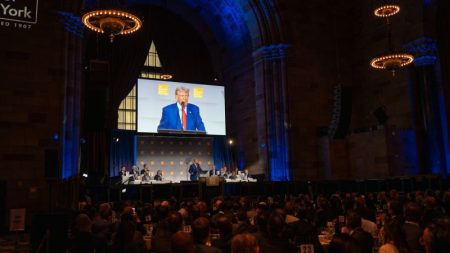Unlock the Editor’s Digest for free
Roula Khalaf, Editor of the FT, selects her favourite stories in this weekly newsletter.
Good morning. Bill Huang, whose Archegos hedge fund blew up spectacularly a few years ago, has been found guilty of fraud. I still have the same question about Hwang I have always had. How could he have thought that his crazy plan was going to make money in the end? Send your theories: [email protected].
The Nvidia sceptics
Before discussing whether it remains wise to own Nvidia shares, take a moment to consider where expectations for the company stand. Here is a picture of historical and expected earnings per share. It also shows where earnings per share expectations were a year ago:

Nvidia’s revenue is expected to double in the current fiscal year, to $120bn. That is not a stretch: in May the company said it expected revenue of $28bn in the current quarter (the second of the fiscal year). The more striking thing is that analysts expect revenue to more than double again in the next four years after that, to reach $245bn in the fiscal year ending in January 2029. For context, total sales of all semiconductors was $533bn in 2023, according to Gartner.
The great AI hardware buildout is, in other words, nowhere near its peak. Nor do analysts expect competition to increase: operating margins are expected to remain above 50 per cent out to the horizon. Hence the staggering rise in earnings pictured above.
I’m not sure how much we can read into analysts’ forecasts for more than a few years out in the future, except as loud, enthusiastic noises. But Nvidia’s shares have gone from trading at 25 times this year’s earnings to 45 times in the last 6 months. This suggests that investors either believe in a future similar to the one the analysts foresee, or are playing a game that has nothing to do with earnings expectations at all.
This burgeoning enthusiasm is the background against which we must assess the arguments of Nvidia sceptics. Loyal Unhedged readers have already been exposed to two examples of this rare species. Here, from March, is NYU professor Aswath Damodaran, explaining why he had sold down much of his Nvidia position (on which he had made a bundle):
So with Nvidia at [$85], it seems to me, the price has run ahead of the [story]. I did a reverse engineering of how big the AI market would have to be and how big Nvidia’s share would have to be to justify the price. This was at [$45]. And I worked out that the AI chip market would have to be about $500bn, and Nvidia would have to have 80 per cent of the market, to essentially break even.
The stock is now at $135, so you can imagine what the implied value of the AI chip market looks like now.
Another form of scepticism notes that if Nvidia is going to grow as much as its price implies, its customers’ AI investment plans must be absolutely huge. And while those customers’ plans are big, they are not big enough. Either the likes of Microsoft, Google and Meta have to spend more than currently expected, or Nvidia must earn less than expected. Charles Cara of Absolute Strategy Research has made this point, as we discussed a few weeks ago.
A multi-part sceptical argument about AI technology, and by implication Nvidia, was recently made by Jim Covello, Goldman Sachs head of global equity research and longtime tech analyst. It runs something like this:
-
AI capacity is expensive to build and run — much more expensive than the technologies and business process it aims to replace. This is in contrast with previous technological innovations, such as the internet, which were cheaper than what they replaced.
-
AI won’t become cheaper as more people use it, as many technologies do, unless the market for the underlying hardware becomes highly competitive, and it might not. Nvidia’s position in AI chips is like ASML’s in high-end chip lithography, which has proven all but unassailable.
-
People overestimate what AI is capable of today. It is, for example, not good at providing basic but accurate summaries of complex information.
-
The great use case for AI has not been specified. With earlier technologies such as the smartphone, the ultimate use cases were laid out — mostly accurately — even when the technology was in its nascent stages. AI might create process efficiencies in areas like software coding, but no revolutionary application has been found or even suggested.
There is plenty here to both agree or disagree with (in particular, is No 3 really correct?). But for me the interesting thing is what Covello says next. He thinks that the pressure of the hype cycle will force companies to continue investing in AI, and therefore it will be wise to stay invested in the companies that benefit from that investment — chipmakers, utilities and so on — even if those companies look expensive.
The end of the cycle will only come if moneymaking applications of AI have not arrived by the time of the next economic slowdown. In an environment of falling profits, investor tolerance for expensive, low-return experiments will disappear and the AI boom will end. Many people describe Nvidia as selling picks and shovels for the AI gold rush. It’s a good metaphor. But if no one discovers gold before the next recession, the rush will end abruptly.
I find Covello’s argument compelling. This is partly because one area where AI would seem to have lots of applications is investing, which is, after all, about finding the signal in lots and lots of noisy information. But the small sample of quantitative finance people I talk to about it seem not to be terribly impressed. Several of them have said that AI simply does what they have been doing for a while, only with more computer power. But Nvidia is not priced for AI to be an evolutionary technology. It is priced for revolution.
One good read
Doll people.
Read the full article here



